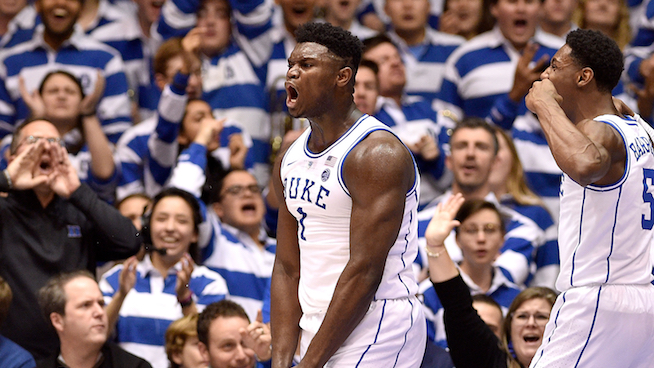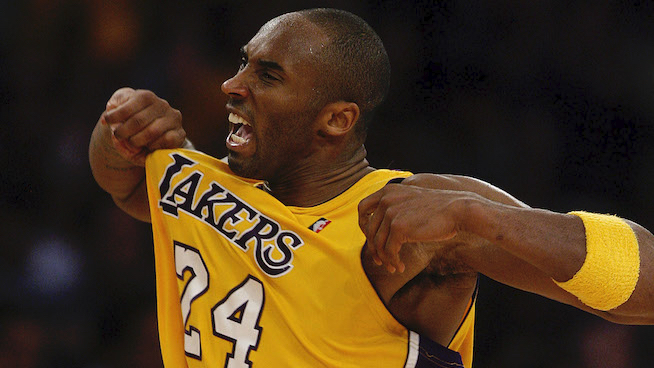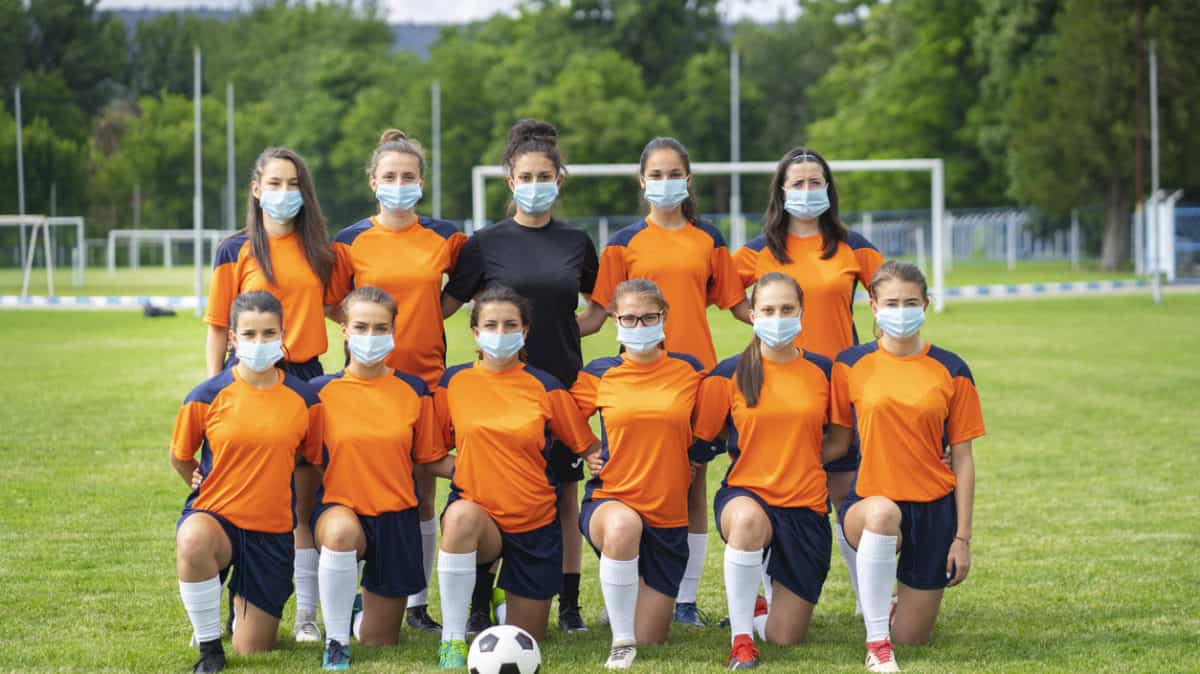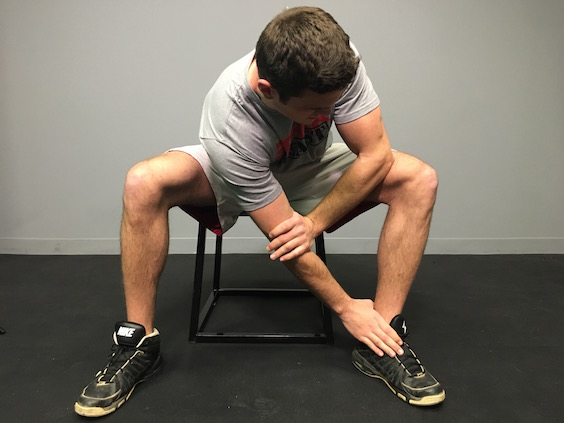Feed the Beasts: Nutrition Strategies That Power Duke Basketball
Duke is college basketball royalty.
The Blue Devils have missed the big dance just once since 1983, racking up five national titles during that span. Now, they’re striving for number six. The job of fueling the über-talented team falls to Beth Miller, Director of Sports Nutrition for Duke Athletics.
To compete for college basketball’s ultimate crown, Miller must get the team’s freshmen studs fueling better, and fast. Four of Duke’s five starters last season were one-and-dones, and that number could be matched this year. The biggest goal is to change the “high school” habits of eating they often bring with them to Durham.
“They get into high school mode where maybe they’ll eat breakfast before they go, maybe not. And then throughout the day, a class schedule of what high school is like, they’re from class to class, then all of a sudden it’s practice time. So they kinda go all day without really planning and having any snacks or anything along with them, then they’re starting practice under-fueled or dehydrated,” Miller says. “A lot of what we get is kids that have gotten this far because they’re naturally talented. They don’t understand how paying more attention to what they’re doing throughout the day prior to getting to practice will actually help them.”
At the start of the year, Miller goes over some essential nutrition tips with the team. One is that she never wants to see them walking around campus without a water bottle. “At the beginning of every school year, everyone gets their brand new re-fillable water bottle that I kinda make mandatory of them to carry to class,” Miller says.
The bare minimum of daily fluid intake she recommends is a half-ounce per pound of body weight, but elite hydration levels are closer to one ounce per pound. For a player like R.J. Barrett, who tips the scales at about 200 pounds, that equates to roughly 0.8 to 1.55 gallons a day. Miller must deal with certain players who simply hate to drink plain water, which is where Gatorade’s Zero and G2 options can be a lifesaver. “We’ve used (those) a ton this year, because we do find a lot of kids that don’t like water, they won’t drink it by itself,” Miller says.
Another focus is eating “gold-medal snacks” between classes. Miller wants the players eating every 2-3 hours, which means toting around some snacks in their backpack throughout the day. For a snack to be a “gold-medal snack” it must pair lean protein with a quality carbohydrate. That could mean something like beef jerky or a cheese stick paired with a piece of fruit or a granola bar. Those options and more are available in the team’s player lounge. “One tagline I say is ‘Your snacks in your backpack for class are just as important as the book,’” Miller says.

The late-night snack is another area where most high school and college students fall into junk food habits. To combat this, Miller will provide players with a to-go box to take home leftovers from that night’s training table dinner. The spread always contains a couple different protein options (poultry plus beef or fish), two hot vegetables (one always being broccoli or green beans), two hot starches (such as potatoes and rice), a salad bar, fresh fruit, then a rotating “Action Bar” where the chef will put out options for build-your-own pasta, tacos, etc. The chef has a code of “locally-sourced, fresh never frozen,” so even the tacos or burgers are a nutritional cut above what you’d find at a drive-thru.
Still, Miller knows college kids love ordering delivery. That’s why she also provides players with menus from popular local eateries with circles around the smarter options. “Restaurants that are open late, either on or off campus, that I know they’re going to get delivery from often, I’ve already pulled menu items from those restaurants that I would want them to choose for that night-time snack,” Miller says.
A near universal requirement for new freshmen is that they must learn to eat more. Exactly how much more depends on their body composition and goals (285-pound Zion Williamson will put down a lot more than 183-pound Tre Jones, for example), but most high school athletes consume hundreds—if not thousands—fewer calories than they need to support high performance. Rather than immediately bombarding players with painfully big portions right off the bat, Miller gradually eases them into greater calorie intakes. “It’s a slow increase. Adding an extra portion of starch at dinner. Then next week at breakfast, an extra serving of protein or something of that sort. But it’s a slow increase,” Miller says. “One thing I really push with some of our weight gain guys is always drinking a caloric beverage with all your meals. So like milk, fruit juice—especially post-training…Liquids are going to go down a lot easier. One thing we also try to do, especially for our weight gain guys, is send them with an extra case of Gatorade Protein Shakes to have right before bed. That’s actually one of my favorite things to do and one of the ways I’ve been most successful.”
The Blue Devils recently added a new weapon to their nutrition game—the Gatorade Fuel Bar. Opened in December immediately adjacent to the team’s practice courts, it’s helped the players take a bigger interest in their pre- and post-activity fueling. Prior to the bar’s opening, the team had little more than a refrigerator in the weight room for such purposes. The bar contains multiple top-of-the-line blenders, a full suite of smoothie ingredients, several ready-to-drink options, plus some portable snacks (skip to 2:11 in the below video to check out this area):
“It’s extremely convenient, and it looks phenomenal, which is gonna draw the guys over there,” Miller says. The bar has been particularly useful for whipping up the team’s post-game shakes. Each recipe is customized to the particular player, so having multiple blenders along with an easy washing station has been hugely convenient. “(With that shake), we’re looking to get fluids back into them and the correct ratio of carbs to protein as well as antioxidants. So we’re throwing everything into it, high antioxidant fruit, Gatorade Whey Protein Power, adding almond milk, orange juice, regular milk, whatever it may be,” Miller says.
READ MORE:
RECOMMENDED FOR YOU
Feed the Beasts: Nutrition Strategies That Power Duke Basketball
Duke is college basketball royalty.
The Blue Devils have missed the big dance just once since 1983, racking up five national titles during that span. Now, they’re striving for number six. The job of fueling the über-talented team falls to Beth Miller, Director of Sports Nutrition for Duke Athletics.
To compete for college basketball’s ultimate crown, Miller must get the team’s freshmen studs fueling better, and fast. Four of Duke’s five starters last season were one-and-dones, and that number could be matched this year. The biggest goal is to change the “high school” habits of eating they often bring with them to Durham.
“They get into high school mode where maybe they’ll eat breakfast before they go, maybe not. And then throughout the day, a class schedule of what high school is like, they’re from class to class, then all of a sudden it’s practice time. So they kinda go all day without really planning and having any snacks or anything along with them, then they’re starting practice under-fueled or dehydrated,” Miller says. “A lot of what we get is kids that have gotten this far because they’re naturally talented. They don’t understand how paying more attention to what they’re doing throughout the day prior to getting to practice will actually help them.”
At the start of the year, Miller goes over some essential nutrition tips with the team. One is that she never wants to see them walking around campus without a water bottle. “At the beginning of every school year, everyone gets their brand new re-fillable water bottle that I kinda make mandatory of them to carry to class,” Miller says.
The bare minimum of daily fluid intake she recommends is a half-ounce per pound of body weight, but elite hydration levels are closer to one ounce per pound. For a player like R.J. Barrett, who tips the scales at about 200 pounds, that equates to roughly 0.8 to 1.55 gallons a day. Miller must deal with certain players who simply hate to drink plain water, which is where Gatorade’s Zero and G2 options can be a lifesaver. “We’ve used (those) a ton this year, because we do find a lot of kids that don’t like water, they won’t drink it by itself,” Miller says.
Another focus is eating “gold-medal snacks” between classes. Miller wants the players eating every 2-3 hours, which means toting around some snacks in their backpack throughout the day. For a snack to be a “gold-medal snack” it must pair lean protein with a quality carbohydrate. That could mean something like beef jerky or a cheese stick paired with a piece of fruit or a granola bar. Those options and more are available in the team’s player lounge. “One tagline I say is ‘Your snacks in your backpack for class are just as important as the book,’” Miller says.

The late-night snack is another area where most high school and college students fall into junk food habits. To combat this, Miller will provide players with a to-go box to take home leftovers from that night’s training table dinner. The spread always contains a couple different protein options (poultry plus beef or fish), two hot vegetables (one always being broccoli or green beans), two hot starches (such as potatoes and rice), a salad bar, fresh fruit, then a rotating “Action Bar” where the chef will put out options for build-your-own pasta, tacos, etc. The chef has a code of “locally-sourced, fresh never frozen,” so even the tacos or burgers are a nutritional cut above what you’d find at a drive-thru.
Still, Miller knows college kids love ordering delivery. That’s why she also provides players with menus from popular local eateries with circles around the smarter options. “Restaurants that are open late, either on or off campus, that I know they’re going to get delivery from often, I’ve already pulled menu items from those restaurants that I would want them to choose for that night-time snack,” Miller says.
A near universal requirement for new freshmen is that they must learn to eat more. Exactly how much more depends on their body composition and goals (285-pound Zion Williamson will put down a lot more than 183-pound Tre Jones, for example), but most high school athletes consume hundreds—if not thousands—fewer calories than they need to support high performance. Rather than immediately bombarding players with painfully big portions right off the bat, Miller gradually eases them into greater calorie intakes. “It’s a slow increase. Adding an extra portion of starch at dinner. Then next week at breakfast, an extra serving of protein or something of that sort. But it’s a slow increase,” Miller says. “One thing I really push with some of our weight gain guys is always drinking a caloric beverage with all your meals. So like milk, fruit juice—especially post-training…Liquids are going to go down a lot easier. One thing we also try to do, especially for our weight gain guys, is send them with an extra case of Gatorade Protein Shakes to have right before bed. That’s actually one of my favorite things to do and one of the ways I’ve been most successful.”
The Blue Devils recently added a new weapon to their nutrition game—the Gatorade Fuel Bar. Opened in December immediately adjacent to the team’s practice courts, it’s helped the players take a bigger interest in their pre- and post-activity fueling. Prior to the bar’s opening, the team had little more than a refrigerator in the weight room for such purposes. The bar contains multiple top-of-the-line blenders, a full suite of smoothie ingredients, several ready-to-drink options, plus some portable snacks (skip to 2:11 in the below video to check out this area):
“It’s extremely convenient, and it looks phenomenal, which is gonna draw the guys over there,” Miller says. The bar has been particularly useful for whipping up the team’s post-game shakes. Each recipe is customized to the particular player, so having multiple blenders along with an easy washing station has been hugely convenient. “(With that shake), we’re looking to get fluids back into them and the correct ratio of carbs to protein as well as antioxidants. So we’re throwing everything into it, high antioxidant fruit, Gatorade Whey Protein Power, adding almond milk, orange juice, regular milk, whatever it may be,” Miller says.
READ MORE:










